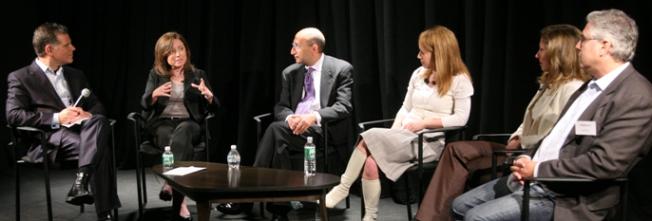Branded Entertainment, Online Video, Search and the Power of Digital Media Assessed by Marketer, Media Agency and Digital Media Execs

Social networking and the means by which digital technology has empowered consumers of media and merchandise alike were the dominant themes at the JackMyers Future of Media discussion earlier this week. The auditorium at the Helen Mills Theater was filled to capacity as Aegis North America’s Sarah Fay, Colgate Palmolive’s Jack Haber, blip.tv's Dina Kaplan, Worldwide Biggies' Albie Hecht and former Coca-Cola executive Shane Steele engagingly discussed the Realities of Dealing with the Changing Media Marketplace with moderator Jack Myers. (When was the last time you found yourself in an auditorium full of media executives and did not see faces all around you unflatteringly illuminated by Blackberries?) The room was largely filled with digital media executives, or at least those who are digitally inclined: When Jack Myers asked audience members how many of them spend 75 percent or more of their time on digital media, almost every hand in the room went up. When he asked how many spend 75 percent or more of their time on traditional media, only a handful of hands were raised.
Myers and his panelists offered fresh and diverse insights into the changes that are sweeping through all areas of media during the digital era, but throughout the session the overall message remained largely the same: consumers are still king, free to devote their time to whatever they desire. But they now hold more power than ever before – including the power to expand a brand.
New Aegis N.A. CEO Fay set the event tone commenting, “The focus is around the consumer. Content is created to be distributed wherever the consumer can be reached.”
Haber, Colgate Palmolive’s Vice President of Global Advertising and eBusiness, said that the new opportunities inherent in digital media “are absolutely terrific for marketers like us. [Digital media] gives us incredible new ways to connect with the consumer; new ways to connect and new ways to advertise. Unlike the mass marketing that our business was built on with lowest common denominator methods, now we can really target messages to people.”
That’s good news but there are concerns, said digital media and marketing consultant and former Director of Emerging Media and Online Advertising at Coca Cola, Shane Steele. “You have to remember that the users are in control and they will figure out ways to get around the advertisement,” she warned.
Advertising today “is about creating great content and great experiences for consumers in a way that you’re not taking away value but adding value,” Steele continued. “[It] is becoming participatory. It isn’t just about creating an ad and putting it out there and people leaning back and watching it. Now people can extend the campaigns within their networks and social media. That social participatory component of what’s happening in digital media is one of the most exciting things happening today.”
Fay reflected on recent successful campaigns that illustrated the power of consumer interaction through digital platforms, among them one for Adidas, in which a community was created on MySpace “because it was right for the brand, not because we understood fully the value of the program,” she explained. “We had creative elements people could take away and put on their own home pages. We would give people a spinning shoe, or a backdrop for their MySpace site. So we could get 600,000 people to the community on a monthly basis, and maybe 75,000 would take something from that and put it on their own site. Not a big number, right? But if you actually added up all the impressions of people who then visited their friends sites with the creative elements it was 21.5 million!
“We think [a] big opportunity [today] is to use offline media to drive toward a more engaging experience,” Fay continued. “We’ve done it with Sony, Reebok, Adidas, brands that are more about someone’s identity -- higher involvement brands where you do have to be focused on building equity over time. It’s been a really phenomenal experience when we’ve been able to make it happen. If you can drive toward something and kick start a community to get involved with a brand you can get your media dollars to carry a lot farther. We built a social networking space for Reebok where you could use Google maps to post your run, connect to iTunes and tell people what you’re playing when you run, and use Flickr to upload photos of yourself during your run. That was [in 2007]. The TV, print and outdoor runs ran from April-June, but the site is still going strong today. There’s more authenticity to that, too, when you get the consumer to talk about your message.”
Are agencies rising to meet the challenges and opportunities inherent in the growth of digital media and the social change it brings? “It’s tempting to sit here and say the agencies don’t get it,” observed blip.tv co-founder and Chief Operating Officer Dina Kaplan. “The digital side is used to buying display ads, which everyone’s eyes just gloss over, and the TV arm is so locked into making 30-second ads and then wanting to stick them before or after a video. The infrastructure to support Web video advertising just is not there yet. We need metrics. We need a way to tell advertisers what they need to know. How many seconds into a video people have watched? How many ad impressions have been watched?”
Worldwide Biggies Chief Executive Officer Albie Hecht agreed. “It’s a challenge to get those metrics out there,” he said. “A lot of it is still voodoo.”
Fay also supported a change in traditional metrics. “You can’t have five different strategies,” she asserted. “We’re still in a phase where a lot of people feel that their campaigns are very integrated as long as everybody is sticking to the same time table and targeting the same audiences. In reality if you want a true holistic strategy that is all about the consumer, somebody has to own the strategy. There is a lot of confusion about who should own the strategy. What is it when you create a community on MySpace? Is that a creative strategy? Is that a media strategy? I would argue that it is both of those things together.”
All of the panelists agreed that the burgeoning growth online of short-form videos, viral or otherwise, is beginning to change the way business is done, and that the full extent of its influence has yet to be felt. “Right now the vast majority of viewing is happening in short form,” Fay noted. “The big opportunity is how do you take advantage of short form? That’s a whole new challenge in how you develop messages.”
There are new challenges in how short-form programming is conceived and developed, as well. “There is a big distinction between redistributing content and taking it from someplace and sticking it someplace else and creating something that’s authentic to the Web and reaching a consumer the way the Web reaches a consumer, which is through an engagement level,” Hecht declared. “You have to be a little bit careful when traditional companies say, ‘we are digital and have multi-platform stuff. That’s like my old colleagues saying SpongeBob is now a podcast for digital. That’s not digital.” [There is a difference between that and what we do] which is purposely create something that is innovative and different and has a different DNA to it, and the way it reaches its audience for advertisers as well as for the consumer.” (Hecht is the former President of Nickelodeon Entertainment.)
“I feel like the networks do have an advantage,” Kaplan admitted. “They have scale and put that behind their content. There are thousands and thousands of people that are creating great shows on the Web, all sorts of production companies coming out of New York, L.A. and San Francisco delivering high quality Web shows. Do they have millions of dollars? No way. I think the networks would be at an advantage if they invested more in their content so that their content is more differentiated rather than less. Whether it’s blip.tv or [somewhere else] we have thousands and thousands of shows that are going to rise and fall. How do you compete against that unless you make a really strong investment in your content?”
Search was also a vital topic for the panelists. “It’s all about making your product or campaign searchable,” Steele said. “Everything is a search engine – YouTube, MySpace. Peer networks are search engines.”
“We use search in a number of ways,” Fay explained. “We have very active search clients that are trying to drive toward an e-commerce solution. Search is a highly efficient way to do that. It is becoming part of the branding campaign. It’s important how you present yourself in a search capacity. You think about your target audience. The center of the target is people who are most interested in your brand or product or surrounding areas of interest. I think search is set to grow consistently probably more than any other medium.
“We believe the brands that will win are the brands whose consumers tell each other the best stories,” she concluded. “There has to be a way to get your brand message out to consumers in a way they care enough about it to talk about it.”
Related:
Sarah Fay, Shane Steele, Jack Haber, Dina Kaplan and Albie Hecht on the Future of Media and Advertising Commentary by Jack Myers
Worldwide Biggies, blip.tv, Aegis and Colgate Palmolive Execs on Digital Advertising Commentary by Nina Spezzaferro
Video Media Metrics Discussed by Execs From blip.tv, Aegis, Colgate Palmolive, Worldwide Biggies and Coca-Cola - JackMyers Daily Data Commentary by: Jennifer Pearson
blip.tv, Colgate Palmolive, Aegis, and Worldwide Biggies Execs Focus on Convergence at JackMyers Event - MediaBizBuzz.com Commentary by Jerry Weinstein
Nina Spezzaferro's in-depth discussion with blip.tv's Dina Kaplan and Worldwide Biggies CEO Albie Hecht.
Later today check out the photos from the event.


